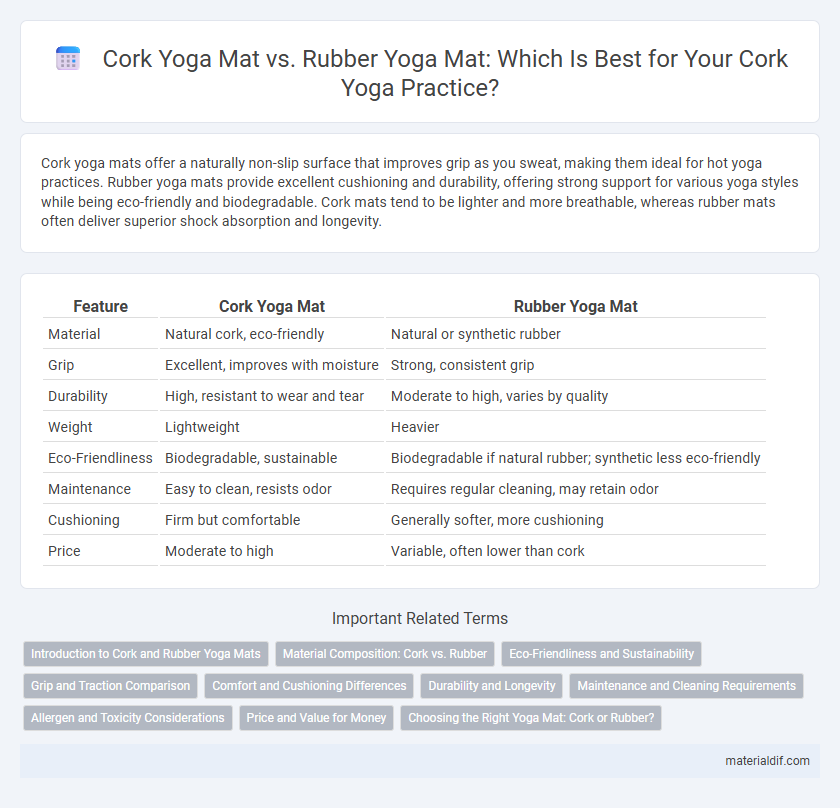Cork yoga mats offer a naturally non-slip surface that improves grip as you sweat, making them ideal for hot yoga practices. Rubber yoga mats provide excellent cushioning and durability, offering strong support for various yoga styles while being eco-friendly and biodegradable. Cork mats tend to be lighter and more breathable, whereas rubber mats often deliver superior shock absorption and longevity.
Table of Comparison
| Feature | Cork Yoga Mat | Rubber Yoga Mat |
|---|---|---|
| Material | Natural cork, eco-friendly | Natural or synthetic rubber |
| Grip | Excellent, improves with moisture | Strong, consistent grip |
| Durability | High, resistant to wear and tear | Moderate to high, varies by quality |
| Weight | Lightweight | Heavier |
| Eco-Friendliness | Biodegradable, sustainable | Biodegradable if natural rubber; synthetic less eco-friendly |
| Maintenance | Easy to clean, resists odor | Requires regular cleaning, may retain odor |
| Cushioning | Firm but comfortable | Generally softer, more cushioning |
| Price | Moderate to high | Variable, often lower than cork |
Introduction to Cork and Rubber Yoga Mats
Cork yoga mats are made from the outer bark of cork oak trees, offering a natural, eco-friendly surface with excellent grip and antimicrobial properties. Rubber yoga mats, typically crafted from natural or synthetic rubber, provide superior cushioning and durability, making them ideal for high-impact poses and long-term use. Both materials deliver distinct benefits that cater to different preferences in grip, comfort, and sustainability.
Material Composition: Cork vs. Rubber
Cork yoga mats are made from natural cork harvested from the bark of cork oak trees, offering a sustainable, biodegradable option with excellent moisture resistance and antimicrobial properties. Rubber yoga mats, typically made from natural or synthetic rubber, provide superior cushioning, flexibility, and durability but may have a stronger odor and potential allergenic effects. Cork mats excel in grip as they become tackier when wet, while rubber mats offer consistent traction and are often heavier due to their dense material composition.
Eco-Friendliness and Sustainability
Cork yoga mats offer superior eco-friendliness due to their renewable harvesting process and natural biodegradability, making them a sustainable choice compared to traditional rubber yoga mats. While rubber mats can be biodegradable, they often involve synthetic additives and longer decomposition times that reduce their environmental benefits. Cork mats also provide durability and antimicrobial properties without harmful chemicals, enhancing their sustainability profile in eco-conscious yoga practices.
Grip and Traction Comparison
Cork yoga mats provide superior grip as they become stickier with moisture, making them ideal for sweaty yoga sessions and hot yoga practices. Rubber yoga mats offer excellent traction through their dense, non-slip surface, ensuring stability on various floor types. While cork mats resist odor and bacteria, rubber mats are prized for durability and consistent traction, especially on smooth or slippery surfaces.
Comfort and Cushioning Differences
Cork yoga mats offer natural resilience and firmness, providing moderate cushioning that adapts to body contours for enhanced comfort during poses. Rubber yoga mats typically deliver superior cushioning with dense, shock-absorbing properties ideal for joint protection and extended practice sessions. The breathable, moisture-wicking surface of cork mats contrasts with the softer, pliable texture of rubber mats, affecting overall comfort based on personal preference and practice intensity.
Durability and Longevity
Cork yoga mats offer superior durability due to their natural resistance to wear and moisture, maintaining structural integrity over extended use. Rubber yoga mats provide excellent longevity with their resilient, flexible material that withstands repeated stretching and pressure without significant degradation. Both materials ensure long-lasting performance, but cork mats excel in eco-friendliness while rubber mats emphasize elasticity and shock absorption.
Maintenance and Cleaning Requirements
Cork yoga mats offer natural antibacterial properties, making them easier to clean and maintain with just a damp cloth, reducing the need for harsh chemicals. Rubber yoga mats require regular washing with mild soap and water to prevent odor buildup and maintain grip over time. Cork mats tend to dry faster, while rubber mats may take longer, necessitating thorough drying to avoid mold growth.
Allergen and Toxicity Considerations
Cork yoga mats offer a natural, hypoallergenic surface free from artificial chemicals, making them ideal for individuals sensitive to allergens. Rubber yoga mats, while providing excellent grip, may release volatile organic compounds (VOCs) or contain latex, which can trigger allergic reactions or toxicity concerns in some users. Choosing cork mats reduces exposure to synthetic toxins and allergens, promoting a healthier practice environment in Cork's wellness community.
Price and Value for Money
Cork yoga mats generally cost more upfront than rubber yoga mats but offer enhanced durability, natural antimicrobial properties, and eco-friendliness, making them a cost-effective investment for long-term use. Rubber yoga mats tend to be more affordable initially but may wear out faster, reducing overall value for money over time. Choosing cork mats provides superior grip and sustainability benefits, which can justify the higher initial price through extended usability and health advantages.
Choosing the Right Yoga Mat: Cork or Rubber?
Cork yoga mats offer excellent grip, natural antimicrobial properties, and eco-friendliness, making them ideal for hot yoga or sweaty practices. Rubber yoga mats provide superior cushioning, durability, and resilience, especially suitable for high-impact or rigorous yoga styles. Choosing the right mat depends on personal preferences for comfort, sustainability, and practice intensity in Cork's active yoga community.
Cork Yoga Mat vs Rubber Yoga Mat Infographic

 materialdif.com
materialdif.com